Top Accessible Grand European Vacations
By John Sage
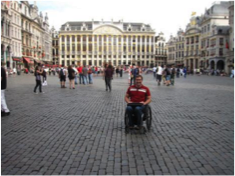
These 3 to 4 week Accessible Grand European Vacations visit several cities and follow a comfortable, stress-free itinerary!
Whether you’re interested in hitting the highlights of Europe, adding in some small towns, or focusing on North or South Europe, Sage Traveling will help you design your ideal Grand European accessible vacation!
#28 – The Highlights of Europe – London, Paris, Rome, Florence, Venice in 23 days
![]() This accessible vacation itinerary visits the most popular tourist destinations in Europe. I suggest spending at least 23 nights visiting these 5 destinations. While it’s certainly possible to move quicker, it can get exhausting to squeeze everything in, and you’ll end up skipping world-class attractions just to rush to the next city.
This accessible vacation itinerary visits the most popular tourist destinations in Europe. I suggest spending at least 23 nights visiting these 5 destinations. While it’s certainly possible to move quicker, it can get exhausting to squeeze everything in, and you’ll end up skipping world-class attractions just to rush to the next city.
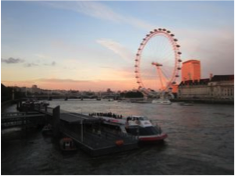
- London – I recommend starting in London where you’ll have fewer language barriers while you practice some of our accessible travel tips and tricks. Five nights in London will allow you to see most of the London highlights like the London Eye on the Thames (shown in the photo on the right) plus take a day-trip to a site outside of London such as Stonehenge, Windsor Castle, Cambridge, Oxford, Hampton Court, or Greenwich.
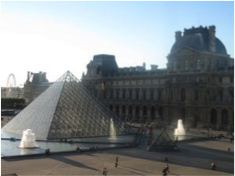 Paris – After an accessible train ride to Paris, five nights in the City of Light will give you a good bit of time to visit the museums, churches, monuments, and unique Parisian neighborhoods. You’ll be able to visit world-renowned attractions like the Eiffel Tower, the Louvre Museum (shown in the photo on the right), the Arc de Triomphe, and the Orsay Museum. Additionally,you’ll be able to experience some lesser-known attractions off the beaten path like the Marmottan Monet Museum, the Sacre Coeur church, the Tuileries Gardens, and an accessible boat cruise on the Seine River. Many of our clients choose an accessible dinner cruise in Paris, and give us rave reviews about it!
Paris – After an accessible train ride to Paris, five nights in the City of Light will give you a good bit of time to visit the museums, churches, monuments, and unique Parisian neighborhoods. You’ll be able to visit world-renowned attractions like the Eiffel Tower, the Louvre Museum (shown in the photo on the right), the Arc de Triomphe, and the Orsay Museum. Additionally,you’ll be able to experience some lesser-known attractions off the beaten path like the Marmottan Monet Museum, the Sacre Coeur church, the Tuileries Gardens, and an accessible boat cruise on the Seine River. Many of our clients choose an accessible dinner cruise in Paris, and give us rave reviews about it!
 Rome – To get from Paris to Rome, you can choose to either fly (cheaper and quicker) or take a first-class, accessible train car (easier and more scenic). Once you arrive in Rome, you’ll have 6 days to sightsee, experience Italian cuisine, and learn all about the Eternal City. I recommend taking 3 guided tours while you’re here: 1) Ancient Rome including the Colosseum, Roman Forum, and emperor’s palaces on Palatine Hill, 2) the Vatican including the Sistine Chapel (shown in the photo on the right), the Raphael Rooms, and St. Peter’s Basilica, and 3) Renaissance Rome including the Trevi Fountain, the Spanish Steps, and Bernini’s Fountain of the Four Rivers.For the remaining 3 days in Rome, you can hire a guide or explore on your own. Museums like the Capitoline Museums, the Borghese Gallery, the Vatican Museum, and the National Museum of Rome contain art and artifacts from throughout the centuries. Renaissance artists designed numerous works of art for Rome churches, and you can still see them in places like the Church of Santa Maria of the Angels and Martyrs, the Santa Maria Maggiore church, the St. Peter in Chains church, the Basilica of St. John Lateran, the Santa Maria Sopra Minerva church, and more.
Rome – To get from Paris to Rome, you can choose to either fly (cheaper and quicker) or take a first-class, accessible train car (easier and more scenic). Once you arrive in Rome, you’ll have 6 days to sightsee, experience Italian cuisine, and learn all about the Eternal City. I recommend taking 3 guided tours while you’re here: 1) Ancient Rome including the Colosseum, Roman Forum, and emperor’s palaces on Palatine Hill, 2) the Vatican including the Sistine Chapel (shown in the photo on the right), the Raphael Rooms, and St. Peter’s Basilica, and 3) Renaissance Rome including the Trevi Fountain, the Spanish Steps, and Bernini’s Fountain of the Four Rivers.For the remaining 3 days in Rome, you can hire a guide or explore on your own. Museums like the Capitoline Museums, the Borghese Gallery, the Vatican Museum, and the National Museum of Rome contain art and artifacts from throughout the centuries. Renaissance artists designed numerous works of art for Rome churches, and you can still see them in places like the Church of Santa Maria of the Angels and Martyrs, the Santa Maria Maggiore church, the St. Peter in Chains church, the Basilica of St. John Lateran, the Santa Maria Sopra Minerva church, and more.
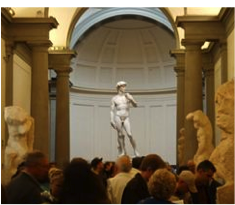 Florence – Florence is one of my favorite cities in Europe because the walking tour is an incredible journey through the Renaissance. You’ll walk/roll along the footsteps of Michelangelo, and learn how Lorenzo de Medici and Pope Julius II championed his artistic projects.You can view Michelangelo’s David in the Accademia (shown in the photo on the right), and one of the best collections in the world for Renaissance art in the Uffizi Gallery. The Ponte Vecchio bridge, Pitti Palace, the Santa Croce church, and the first dome created during the Renaissance at Florence’s Duomo Cathedral.During your 4 day stay in Florence, you will also have time to take a day trip to experience Tuscany in neighboring small towns. Siena’s famous Piazza del Campo town square, the fourteen towers of San Gimignano, the Leaning Tower of Pisa, and an accessible Chianti winery visit are just a few of the day-trip options that you’ll have. The Ponte Vecchio bridge, Pitti Palace, the Santa Croce church, and the first dome created during the Renaissance at Florence’s Duomo Cathedral.
Florence – Florence is one of my favorite cities in Europe because the walking tour is an incredible journey through the Renaissance. You’ll walk/roll along the footsteps of Michelangelo, and learn how Lorenzo de Medici and Pope Julius II championed his artistic projects.You can view Michelangelo’s David in the Accademia (shown in the photo on the right), and one of the best collections in the world for Renaissance art in the Uffizi Gallery. The Ponte Vecchio bridge, Pitti Palace, the Santa Croce church, and the first dome created during the Renaissance at Florence’s Duomo Cathedral.During your 4 day stay in Florence, you will also have time to take a day trip to experience Tuscany in neighboring small towns. Siena’s famous Piazza del Campo town square, the fourteen towers of San Gimignano, the Leaning Tower of Pisa, and an accessible Chianti winery visit are just a few of the day-trip options that you’ll have. The Ponte Vecchio bridge, Pitti Palace, the Santa Croce church, and the first dome created during the Renaissance at Florence’s Duomo Cathedral.
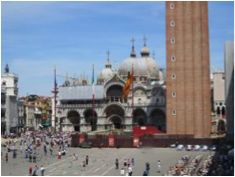 Venice – After a comfortable and scenic first-class train ride to Venice, you’ll be greeted by an accessible water taxi to bring you to your accessible hotel. Believe it or not, with the right strategy, wheelchair users can avoid many of the 409 bridges in Venice. With 3 nights in Venice, you’ll be able to see the main sights like the Doge’s Palace, the Rialto Bridge, and St. Mark’s Basilica (shown in the photo on the right), as well as get away from the tourist crowds to visit the more charming parts of Venice.
Venice – After a comfortable and scenic first-class train ride to Venice, you’ll be greeted by an accessible water taxi to bring you to your accessible hotel. Believe it or not, with the right strategy, wheelchair users can avoid many of the 409 bridges in Venice. With 3 nights in Venice, you’ll be able to see the main sights like the Doge’s Palace, the Rialto Bridge, and St. Mark’s Basilica (shown in the photo on the right), as well as get away from the tourist crowds to visit the more charming parts of Venice.
This trip is fairly complex, but you don’t have to plan it on your own. We’ve researched accessibility first-hand in all of these cities and we’ve planned numerous accessible trips to these destinations. We’ll make sure that your accessible vacation to Europe is easy, accessible, and memorable!
#29 – The Highlights plus Small Towns (Cambridge, Bruges, & Lucca) in 29 days
This European accessible vacation adds a few charming small towns to the Accessible Vacation #28 described above. When most people think about visiting Europe, they think about highlights like Big Ben, the Eiffel Tower, and the Colosseum. However, after returning from a trip, many people say that their favorite experiences were actually in the small charming towns that they didn’t know much about.
- London, Paris, Rome, Florence, and Venice – Described in Accessible Vacation #28
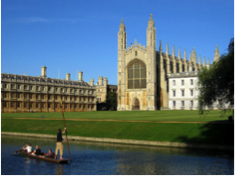 Cambridge – From London, you can easily add a couple nights’ stay in the historical and charming town of Cambridge. Home to one of the top universities in the world (shown in the photo on the right), Cambridge will provide you a quaint setting to view buildings built over the last several centuries. A blue badge, officially licensed tour guide can show you the historical buildings and tell you about the famous Cambridge alumni who have changed the world.
Cambridge – From London, you can easily add a couple nights’ stay in the historical and charming town of Cambridge. Home to one of the top universities in the world (shown in the photo on the right), Cambridge will provide you a quaint setting to view buildings built over the last several centuries. A blue badge, officially licensed tour guide can show you the historical buildings and tell you about the famous Cambridge alumni who have changed the world.
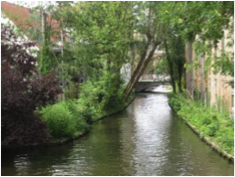 Bruges – From Paris, a couple of easy accessible train rides will bring you to one of the best-preserved medieval towns in Europe. When the harbor silted up in the 16th century, old buildings were preserved rather than torn down. Consequently, visiting Bruges is like going back in time! The town itself is the main attraction here, with its quaint streets and canals (shown in the photo on the right), but you can also visit the Church of the Holy Blood, the Burg Square, and the Groeninge Museum. Three nights here will allow you to spend at least two days enjoying this beautiful town.
Bruges – From Paris, a couple of easy accessible train rides will bring you to one of the best-preserved medieval towns in Europe. When the harbor silted up in the 16th century, old buildings were preserved rather than torn down. Consequently, visiting Bruges is like going back in time! The town itself is the main attraction here, with its quaint streets and canals (shown in the photo on the right), but you can also visit the Church of the Holy Blood, the Burg Square, and the Groeninge Museum. Three nights here will allow you to spend at least two days enjoying this beautiful town.
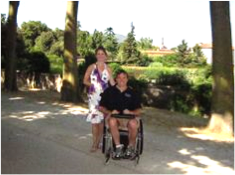 Lucca – While most people visiting Tuscany stay their entire time in Florence, you can easily spend a couple of nights in the small Tuscan town of Lucca. Unlike many other Tuscan towns, the medieval walled town of Lucca contains flat terrain that disabled travelers will appreciate (photo taken on top of medieval city walls shown on the right). You’ll have time to enjoy Italian cuisine in scenic piazzas as well as do some sightseeing in this Tuscan town.
Lucca – While most people visiting Tuscany stay their entire time in Florence, you can easily spend a couple of nights in the small Tuscan town of Lucca. Unlike many other Tuscan towns, the medieval walled town of Lucca contains flat terrain that disabled travelers will appreciate (photo taken on top of medieval city walls shown on the right). You’ll have time to enjoy Italian cuisine in scenic piazzas as well as do some sightseeing in this Tuscan town.
#30 – Best of North Europe – London, Paris, Normandy, Bruges, Brussels, and Amsterdam in 21 days
 This accessible vacation in Europe focuses on some of the best cities in Northern Europe…and disabled travelers will love that they’re also some of the flattest! London (5 nights), Paris (5 nights), and Bruges (3 nights) are described in the two accessible vacations above.
This accessible vacation in Europe focuses on some of the best cities in Northern Europe…and disabled travelers will love that they’re also some of the flattest! London (5 nights), Paris (5 nights), and Bruges (3 nights) are described in the two accessible vacations above.
Three nights in Normandy will allow you a full day to tour the D-day beaches and the military cemeteries located near them. You’ll be able to visit one or two of the World War II Museums and see the 1000-year-old Bayeux Tapestry that documents William the Conqueror’s invasion of England.
During your journey through Belgium, you’ll spend 3 nights relaxing in the scenic town of Bruges, followed by 2 nights in Brussels. While in Brussels you can visit major attractions like the EU Parliament, the Royal Museum of Fine Art, and the Royal Museum of Military History. You’ll also be able to have a dinner of Belgian seafood and the world-famous Belgian beer on the scenic Grand Place plaza!
When your trip finishes with 3 nights in Amsterdam, you’ll be able experience the “Venice of the North” which has many more accessible bridges than its Italian counterpart! The Amsterdam accessible boat tour is the most leisurely way to tour the city and provides outstanding photo opportunities. You’ll also be able to learn about the local WWII history at the Dutch Resistance Museum, and visit Amsterdam’s two most popular art museums: the Van Gogh Museum and the Rijksmuseum. And don’t forget to have a memorable dinner overlooking an Amsterdam Canal!
#31 – Best of South Europe – Barcelona, Monte Carlo, Florence, Rome, Athens, Istanbul in 21 days
 This accessible vacation uses a combination of trains and planes to spend three weeks visiting the top destinations in southern Europe.
This accessible vacation uses a combination of trains and planes to spend three weeks visiting the top destinations in southern Europe.
You’ll start your vacation with 3 nights in the accessible city of Barcelona where you’ll have the opportunity to view Gaudi-designed architecture, the Las Ramblas boulevard, and wheelchair accessible beaches. A first-class train ride will bring you along the French Riviera until you reach the small, spectacular city-state of Monte Carlo. Three nights in Monte Carlo will be ample time to visit tourist attractions like the Royal Palace and Oceanographic Museums, as well as play in Monaco’s Grand Casino and drive along the scenic corniche highway into France.
A scenic train ride through the Alps and through Tuscany will bring you to one of my favorite cities in Europe, the Tuscan city of Florence. You’ll be able to see famous attractions like Michelangelo’s David, the Ponte Vecchio bridge, and the tomb of Galileo. You’ll also have time for some great Florence experiences like the fascinating accessible historical walking tour, dining in small authentic Italian restaurants, and sipping wine from a hill overlooking the city!
Your next stop is Rome where you’ll have 5 days to explore the Eternal City. You’ll have a full day to visit the Sistine Chapel, the Vatican Museums, and St. Peter’s Basilica…and you’ll need the whole day to visit these world-class attractions! The Colosseum and the Roman Forum are popular attractions that are most appreciated with ancient stories told by an official tour guide. The remaining 3 days can be spent visiting a variety of churches, museums, and monuments including the Trevi Fountain, the Pantheon, the Spanish Steps, the National Museum of Rome, and the Fountain of the Four Rivers.
A flight across the Adriatic Sea will bring you back in time to the Greek Empire, which predates the Roman Empire. While many visitors only get a single day to visit Athens on a cruise excursion, you’ll have 3 days in Athens to explore some lesser-known attractions. The Byzantine and Christian Museum presents exhibits from often overlooked medieval historical period, and the Cycladic Art Museum describes the culture of the Greek Islands. Of course you’ll also have time to visit popular attractions like the Parthenon, the Ancient Agora, and the Acropolis Museum!
Your accessible European vacation finishes with 4 nights in Istanbul, Turkey where you’ll be able to visit both Europe and Asia in this city that straddles the two continents. Accessible guided tours are available of the Hagia Sophia, the Blue Mosque, and Topkapi Palace. You’ll also have time to shop in the Grand Bazaar and Spice Market as well as visit the underground Basilica Cistern and the impressive National Archaeological Museum.
Learn more about the Top 50 Awesome Accessible European Vacations:
1-6: London & Paris
7-11: The Low Countries (Belgium, the Netherlands, Denmark, and more)
12-14: Baltic Cruises
16-22: Italy
23-25: Mediterranean Riviera
26-27: Ancient Civilizations
28-31: Europe-wide Vacations
32-34: Mediterranean Cruises from Barcelona
35-38: Mediterranean Cruises from Rome and Istanbul
39-43: Mediterranean Cruises from Venice
44-45: 3 to 4 Week Mediterranean Cruises
46-50: Luxury Mediterranean Cruises


